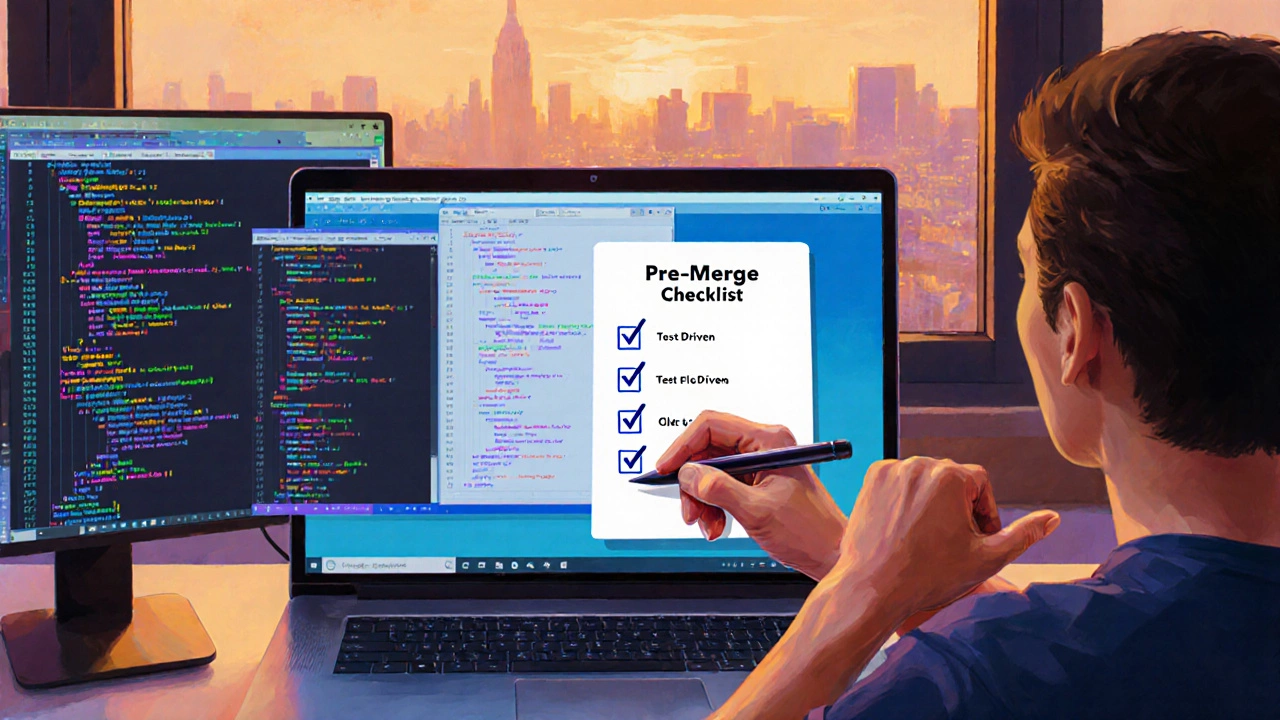Understanding the Golden Rule of Coding: A Practical Guide
 Oct, 17 2025
Oct, 17 2025
Golden Rule Code Quality Checker
Golden Rule Pre-Merge Checklist
Evaluate your code against the Golden Rule: "Write code as if the next person who reads it is a violent psychopath who knows you're not a mind-reader."
Every programmer, from fresh graduates to seasoned architects, has heard the phrase “golden rule of coding.” It’s more than a buzzword - it’s a mindset that can shrink bugs, speed up delivery, and keep your codebase sane for years. This guide breaks down what that rule really is, why it matters, and how you can live by it every day.
Key Takeaways
- The golden rule of coding is “write code as if the next person who reads it is a violent psychopath who knows you’re not a mind‑reader.”
- It bundles three core habits: simplicity, clarity, and maintainability.
- Related principles like DRY, KISS, YAGNI, and SOLID reinforce the golden rule.
- Practical tactics - code reviews, test‑driven development, and regular refactoring - turn the rule into habit.
- A short checklist helps you audit any piece of code before it ships.
What Exactly Is the Golden Rule of Coding?
In its purest form, the golden rule tells you to treat your code like a shared public space. Write it so that anyone - a teammate tomorrow, a future maintainer in five years, or an open‑source contributor - can understand it instantly without guessing your intent.
When you embed this rule in your daily workflow, you automatically avoid obscure one‑liners, undocumented hacks, and tangled spaghetti. The result is a codebase that scales, adapts, and stays bug‑free longer.
Why the Rule Matters More Than Ever
Modern software projects involve dozens of micro‑services, multiple languages, and rapid release cycles. A single unreadable module can become a hidden cost that inflates technical debt dramatically. A 2023 study by the Software Engineering Institute showed that teams spending 20% of each sprint on clean‑up activities reduced production bugs by 35%.
Applying the golden rule reduces onboarding time - new hires can start contributing within days instead of weeks - and it improves collaboration across remote teams, especially in a post‑pandemic world where code reviews happen over video calls rather than “over the shoulder.”
Core Principles That Support the Golden Rule
Several well‑known principles act as concrete extensions of the golden rule. Understanding them helps you apply the rule without feeling lost.
DRY principle is the “Don’t Repeat Yourself” guideline that pushes you to eliminate duplicate logic across your codebase.When similar code appears in multiple places, any change forces you to hunt down each copy, risking inconsistencies. DRY forces you to abstract common behavior into functions, classes, or services, keeping the code DRY and easier to maintain.
KISS principle is the “Keep It Simple, Stupid” rule that reminds you to prefer straightforward solutions over clever but confusing tricks.Complex one‑liners might look impressive, but they hide intent. Simpler code is easier to test, debug, and hand off.
YAGNI principle is the “You Aren’t Gonna Need It” mantra that discourages building features before they are truly required.YAGNI protects you from over‑engineering. Every extra line you write is a future maintenance burden.
SOLID principles are a set of five design guidelines (Single Responsibility, Open/Closed, Liskov Substitution, Interface Segregation, Dependency Inversion) that promote robust, extensible architecture.Solid code respects the golden rule by being modular, testable, and less prone to ripple changes.
Clean Code is a philosophy popularized by Robert C. Martin that emphasizes naming, formatting, and small functions.Following Clean Code guidelines makes the golden rule actionable: you get concrete naming conventions, proper indentation, and clear intent.
How to Live By the Golden Rule Every Day
Knowing the rule is half the battle. Here are five habits that turn theory into practice.
- Code reviews as learning loops. Treat every review as a chance to ask, “Would the next person understand this without a comment?” Encourage reviewers to request clearer naming or simpler logic.
- Test‑Driven Development (TDD). Write a failing test, then write just enough code to pass it. The test serves as living documentation that explains intent.
- Regular refactoring sessions. Schedule bi‑weekly “clean‑up” sprints where the only goal is to simplify existing code, remove dead branches, and apply DRY/KISS.
- Documentation as an after‑thought. Use inline comments sparingly - only when the *why* isn’t obvious. Prefer self‑describing code over bulky docs.
- Adopt a “code health” checklist. Before merging, run through a quick checklist (see next section) to verify you obeyed the golden rule.
Common Pitfalls That Violate the Golden Rule
Even diligent developers slip up. Spot these red flags early:
- Over‑named variables. Giving a variable a clever name like
temp1orfooBarBazusually hides meaning. - Nested conditionals. Deeply nested
ifstatements make the control flow hard to follow. Refactor into guard clauses or strategy patterns. - Magic numbers. Hard‑coded values (e.g.,
if (status == 3)) should become named constants. - Large functions. Anything over 30 lines typically does more than one thing. Split into smaller, purpose‑driven helpers.
- Ignored warnings. Compiler or lint warnings are hints that the code may be confusing. Treat them as errors until resolved.

Golden Rule Checklist - Quick Audit Before You Merge
| Check | Yes / No |
|---|---|
| Is each function under 30 lines? | |
| Are variable and function names self‑descriptive? | |
| Have I removed duplicate logic (DRY)? | |
| Does the code avoid unnecessary complexity (KISS)? | |
| Is there a unit test that explains the intent? | |
| Have I run a linter and fixed all warnings? | |
| Does the code respect SOLID where applicable? | |
| Is any new feature justified (YAGNI)? |
If you answer “yes” to most rows, you’re likely honoring the golden rule. Anything you’re unsure about should be revisited before the merge.
Frequently Asked Questions
Is the golden rule of coding a formal industry standard?
No, it’s not an ISO‑approved standard. It’s a cultural guideline that many teams adopt to improve readability and reduce technical debt.
How does the golden rule differ from Clean Code?
Clean Code is a book‑level philosophy with concrete rules for naming, formatting, and testing. The golden rule is a higher‑level mindset that those Clean Code rules help you achieve.
Can the golden rule be applied to non‑programming artifacts like configuration files?
Absolutely. Clear YAML or JSON, with comments that explain intent, follows the same principle of future readability.
What tools help enforce the golden rule automatically?
Linters (ESLint, RuboCop), static analyzers (SonarQube), and formatters (Prettier) catch many readability violations. Pair them with code‑review bots for continuous enforcement.
Is it ever okay to break the golden rule for performance?
Performance first is a valid exception, but only after measuring impact. Document the trade‑off clearly and plan to revisit the code when hardware improves.
Next Steps for Developers
Pick one habit from the list above and try it for a week. Track how many pull‑requests you had to fix for readability. You’ll see the golden rule’s impact in real metrics - fewer comments, faster merges, and happier teammates.
When building a new project, add the checklist to your CI pipeline as a gating step. When refactoring legacy code, use the rule as a lens: if a line feels cryptic, rewrite it now.
Remember: code is a conversation. Speak clearly, and future developers will thank you.